technical specifications FIAT IDEA 2007 1.G Owners Manual
[x] Cancel search | Manufacturer: FIAT, Model Year: 2007, Model line: IDEA, Model: FIAT IDEA 2007 1.GPages: 314, PDF Size: 4.78 MB
Page 255 of 314
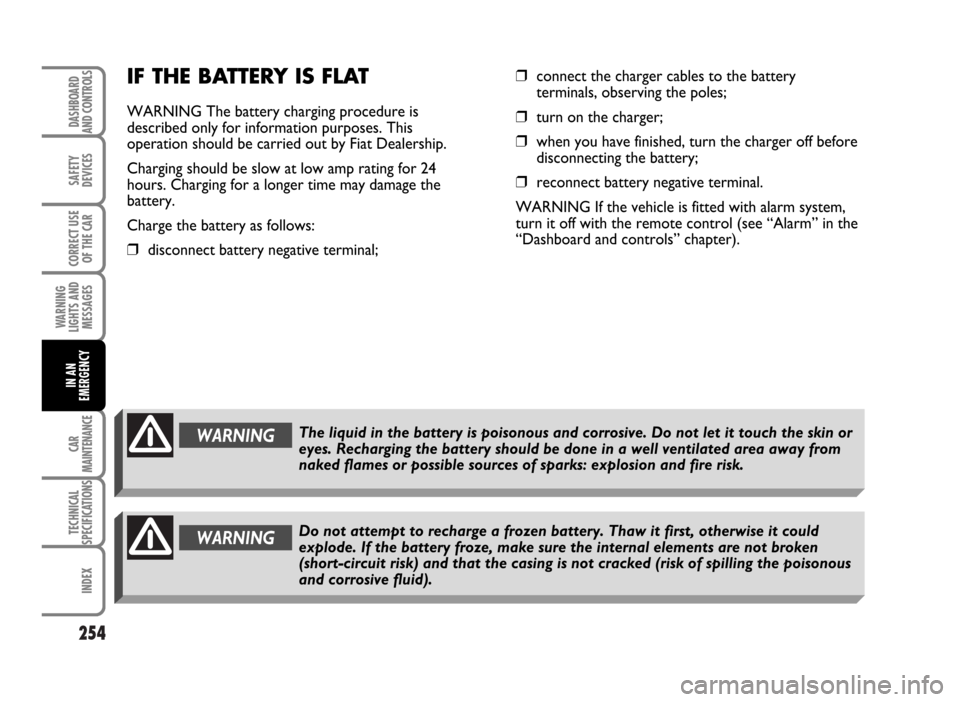
254
SAFETY
DEVICES
CORRECT USE
OF THE CAR
WARNING
LIGHTS AND
MESSAGES
CAR
MAINTENANCE
TECHNICAL
SPECIFICATIONS
INDEX
DASHBOARD
AND CONTROLS
IN AN
EMERGENCY
IF THE BATTERY IS FLAT
WARNING The battery charging procedure is
described only for information purposes. This
operation should be carried out by Fiat Dealership.
Charging should be slow at low amp rating for 24
hours. Charging for a longer time may damage the
battery.
Charge the battery as follows:
❒disconnect battery negative terminal;❒connect the charger cables to the battery
terminals, observing the poles;
❒turn on the charger;
❒when you have finished, turn the charger off before
disconnecting the battery;
❒reconnect battery negative terminal.
WARNING If the vehicle is fitted with alarm system,
turn it off with the remote control (see “Alarm” in the
“Dashboard and controls” chapter).
WARNINGThe liquid in the battery is poisonous and corrosive. Do not let it touch the skin or
eyes. Recharging the battery should be done in a well ventilated area away from
naked flames or possible sources of sparks: explosion and fire risk.
WARNINGDo not attempt to recharge a frozen battery. Thaw it first, otherwise it could
explode. If the battery froze, make sure the internal elements are not broken
(short-circuit risk) and that the casing is not cracked (risk of spilling the poisonous
and corrosive fluid).
Page 256 of 314
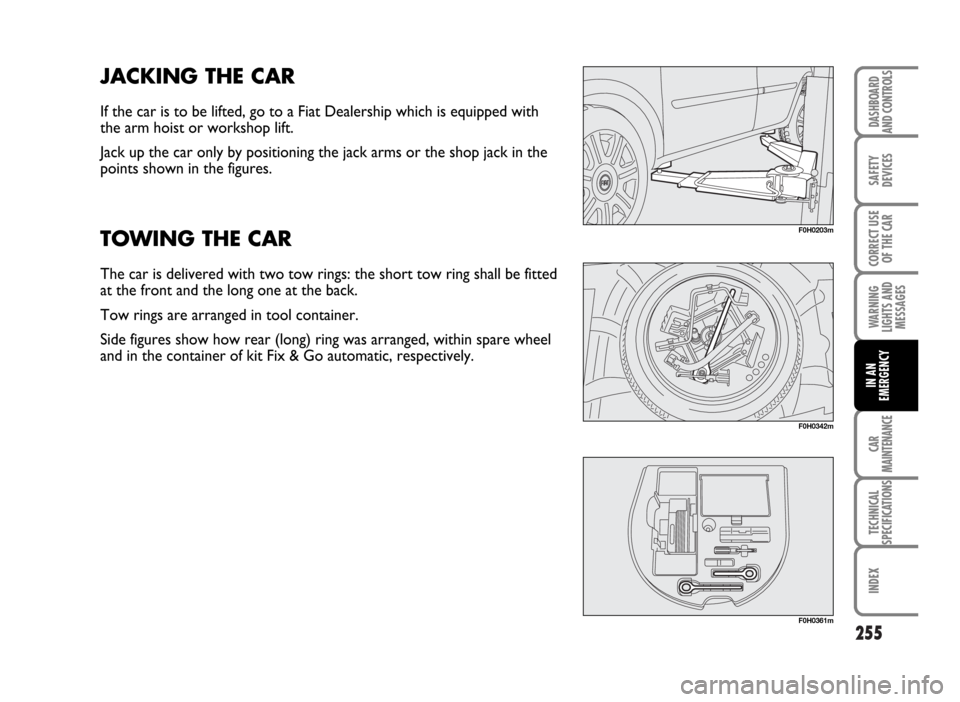
255
SAFETY
DEVICES
CORRECT USE
OF THE CAR
WARNING
LIGHTS AND
MESSAGES
CAR
MAINTENANCE
TECHNICAL
SPECIFICATIONS
INDEX
DASHBOARD
AND CONTROLS
IN AN
EMERGENCY
F0H0203m
JACKING THE CAR
If the car is to be lifted, go to a Fiat Dealership which is equipped with
the arm hoist or workshop lift.
Jack up the car only by positioning the jack arms or the shop jack in the
points shown in the figures.
TOWING THE CAR
The car is delivered with two tow rings: the short tow ring shall be fitted
at the front and the long one at the back.
Tow rings are arranged in tool container.
Side figures show how rear (long) ring was arranged, within spare wheel
and in the container of kit Fix & Go automatic, respectively.
F0H0342m
F0H0361m
Page 257 of 314
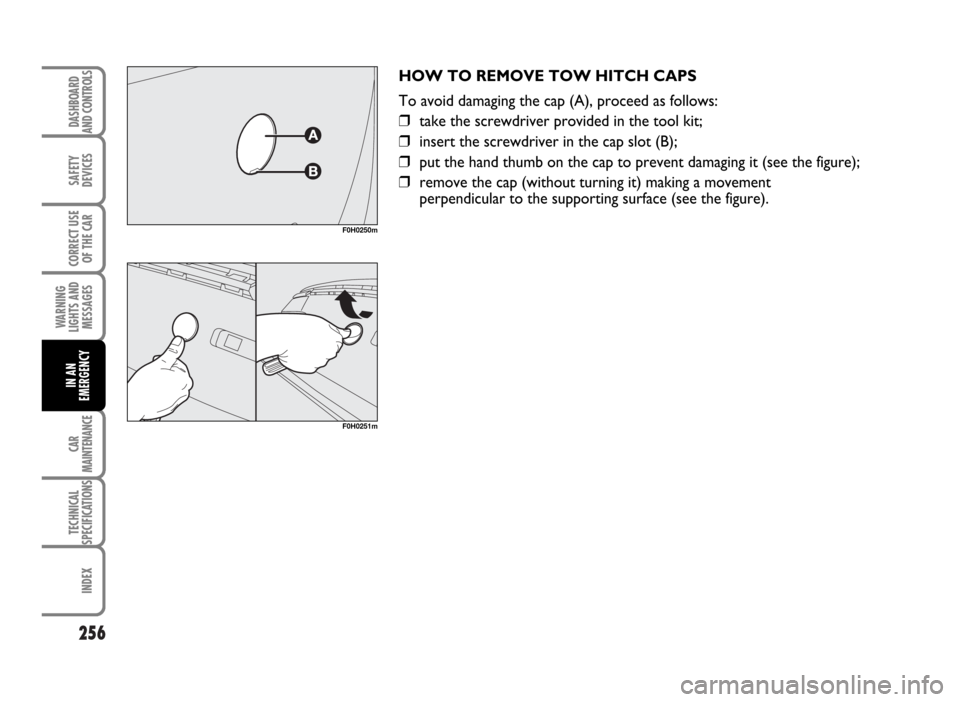
256
SAFETY
DEVICES
CORRECT USE
OF THE CAR
WARNING
LIGHTS AND
MESSAGES
CAR
MAINTENANCE
TECHNICAL
SPECIFICATIONS
INDEX
DASHBOARD
AND CONTROLS
IN AN
EMERGENCY
HOW TO REMOVE TOW HITCH CAPS
To avoid damaging the cap (A), proceed as follows:
❒take the screwdriver provided in the tool kit;
❒insert the screwdriver in the cap slot (B);
❒put the hand thumb on the cap to prevent damaging it (see the figure);
❒remove the cap (without turning it) making a movement
perpendicular to the supporting surface (see the figure).
F0H0250m
F0H0251m
Page 258 of 314

257
SAFETY
DEVICES
CORRECT USE
OF THE CAR
WARNING
LIGHTS AND
MESSAGES
CAR
MAINTENANCE
TECHNICAL
SPECIFICATIONS
INDEX
DASHBOARD
AND CONTROLS
IN AN
EMERGENCY
WARNING
WARNING
Do not start the engine when towing the car.
WARNINGWhile the car is being towed with the
engine off, remember that the brake
pedal and steering will require more
effort as you no longer have the benefit
of the brake booster and the electrical
power steering. Do not use flexible cables
to tow. Avoid jerking. Whilst towing,
ensure that the coupling to the car does
not damage the surrounding components.
When towing the car, you must comply
with the specific traffic regulations
regarding the tow hitch and how to tow
on the road. TOW RING HOOKING
Proceed as follows:
❒take the tow ring (B) from its support;
❒tighten the ring on the rear or front threaded pin.
F0H0204m
F0H0205m
Before starting to tow, turn the ignition
key to MAR and then to STOP. Do not
remove the key. If the key is removed, the
steering lock engages automatically which
prevents the wheels being turned.
Page 259 of 314
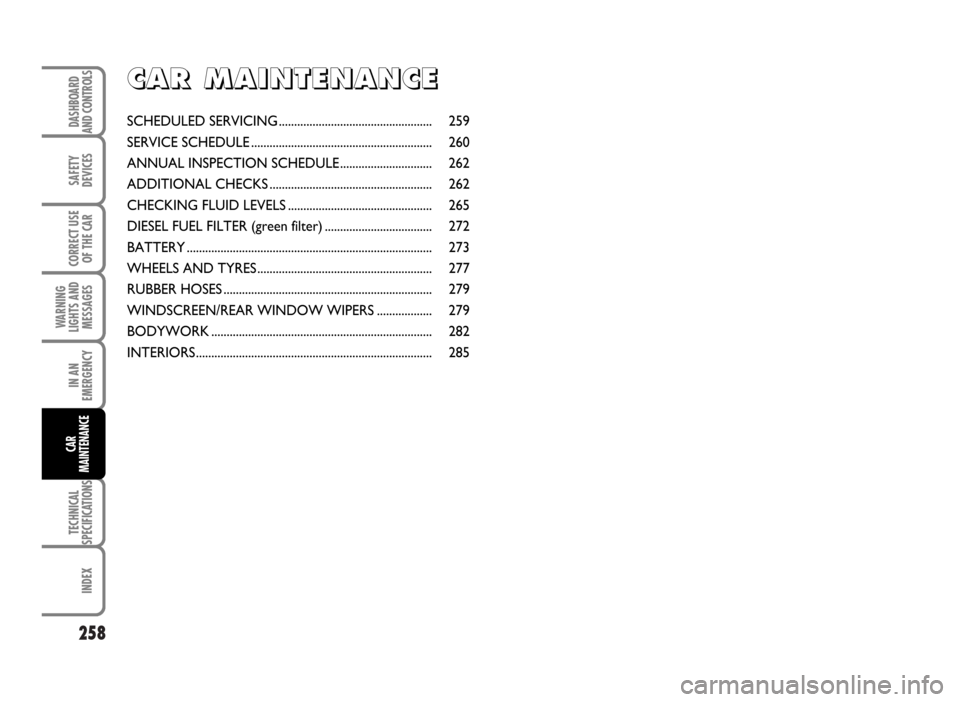
258
SAFETY
DEVICES
CORRECT USE
OF THE CAR
WARNING
LIGHTS AND
MESSAGES
IN AN
EMERGENCY
TECHNICAL
SPECIFICATIONS
INDEX
DASHBOARD
AND CONTROLS
CAR
MAINTENANCE
C C
A A
R R
M M
A A
I I
N N
T T
E E
N N
A A
N N
C C
E E
SCHEDULED SERVICING .................................................. 259
SERVICE SCHEDULE ........................................................... 260
ANNUAL INSPECTION SCHEDULE .............................. 262
ADDITIONAL CHECKS ..................................................... 262
CHECKING FLUID LEVELS ............................................... 265
DIESEL FUEL FILTER (green filter) ................................... 272
BATTERY ................................................................................ 273
WHEELS AND TYRES ......................................................... 277
RUBBER HOSES .................................................................... 279
WINDSCREEN/REAR WINDOW WIPERS .................. 279
BODYWORK ........................................................................ 282
INTERIORS............................................................................. 285
Page 260 of 314
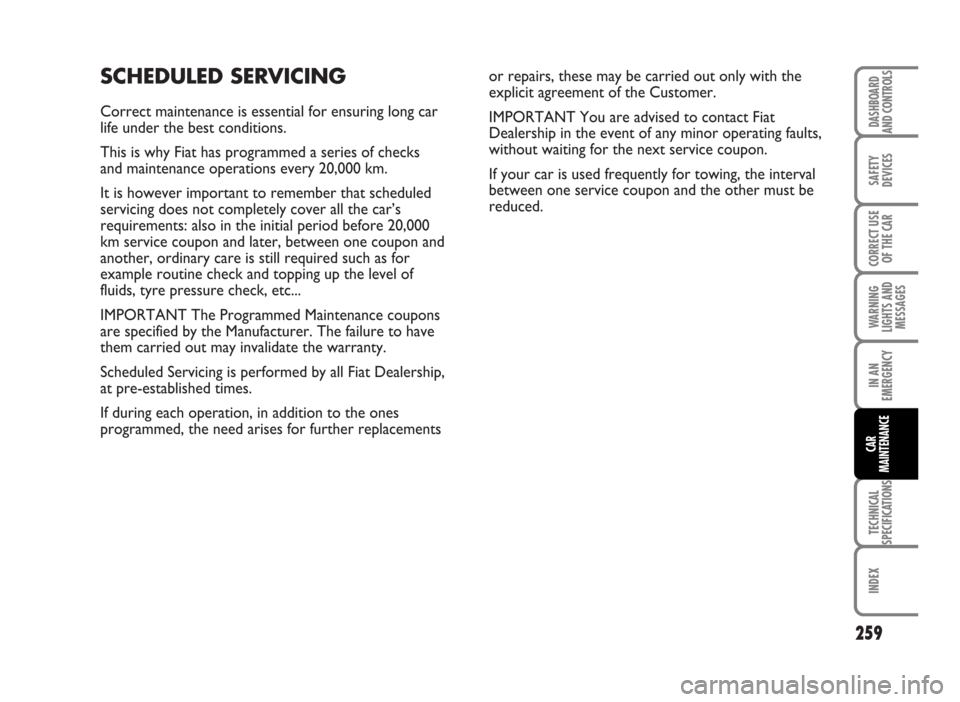
SCHEDULED SERVICING
Correct maintenance is essential for ensuring long car
life under the best conditions.
This is why Fiat has programmed a series of checks
and maintenance operations every 20,000 km.
It is however important to remember that scheduled
servicing does not completely cover all the car’s
requirements: also in the initial period before 20,000
km service coupon and later, between one coupon and
another, ordinary care is still required such as for
example routine check and topping up the level of
fluids, tyre pressure check, etc...
IMPORTANT The Programmed Maintenance coupons
are specified by the Manufacturer. The failure to have
them carried out may invalidate the warranty.
Scheduled Servicing is performed by all Fiat Dealership,
at pre-established times.
If during each operation, in addition to the ones
programmed, the need arises for further replacementsor repairs, these may be carried out only with the
explicit agreement of the Customer.
IMPORTANT You are advised to contact Fiat
Dealership in the event of any minor operating faults,
without waiting for the next service coupon.
If your car is used frequently for towing, the interval
between one service coupon and the other must be
reduced.
259
SAFETY
DEVICES
CORRECT USE
OF THE CAR
WARNING
LIGHTS AND
MESSAGES
IN AN
EMERGENCY
TECHNICAL
SPECIFICATIONS
INDEX
DASHBOARD
AND CONTROLS
CAR
MAINTENANCE
Page 261 of 314
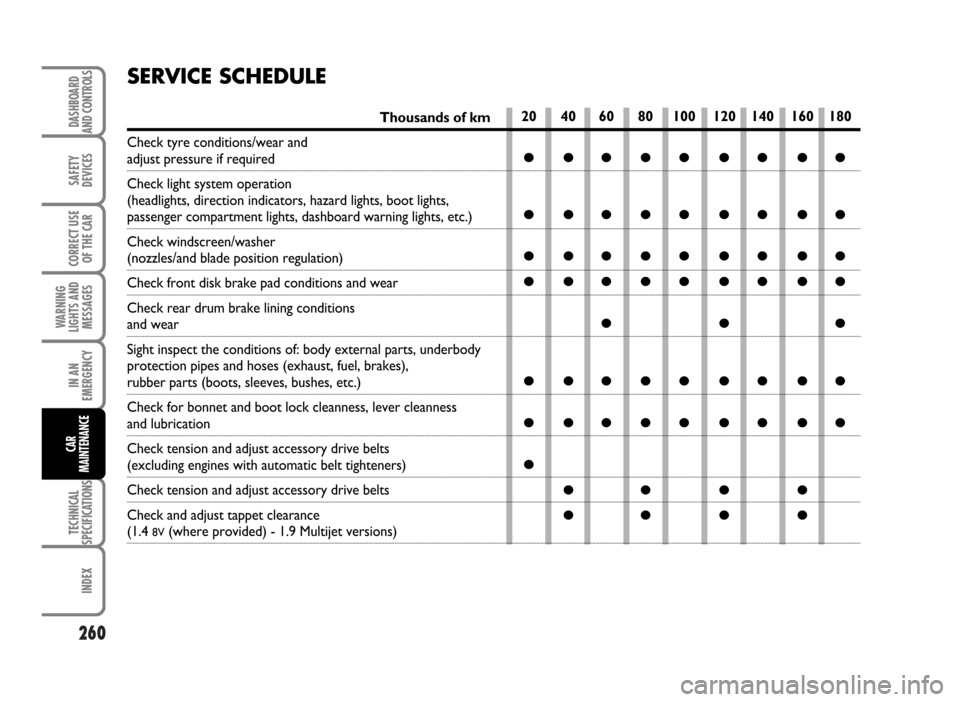
260
SAFETY
DEVICES
CORRECT USE
OF THE CAR
WARNING
LIGHTS AND
MESSAGES
IN AN
EMERGENCY
TECHNICAL
SPECIFICATIONS
INDEX
DASHBOARD
AND CONTROLS
CAR
MAINTENANCE
SERVICE SCHEDULE
Thousands of km
Check tyre conditions/wear and
adjust pressure if required
Check light system operation
(headlights, direction indicators, hazard lights, boot lights,
passenger compartment lights, dashboard warning lights, etc.)
Check windscreen/washer
(nozzles/and blade position regulation)
Check front disk brake pad conditions and wear
Check rear drum brake lining conditions
and wear
Sight inspect the conditions of: body external parts, underbody
protection pipes and hoses (exhaust, fuel, brakes),
rubber parts (boots, sleeves, bushes, etc.)
Check for bonnet and boot lock cleanness, lever cleanness
and lubrication
Check tension and adjust accessory drive belts
(excluding engines with automatic belt tighteners)
Check tension and adjust accessory drive belts
Check and adjust tappet clearance
(1.4 8V(where provided) - 1.9 Multijet versions)
20 40 60 80 100 120 140 160 180
●●●●● ●●●●
●●●●● ●●●●
●●●●● ●●●●
●●●●● ●●●●
●●●
●●●●● ●●●●
●●●●● ●●●●
●
●● ● ●
●● ● ●
Page 262 of 314
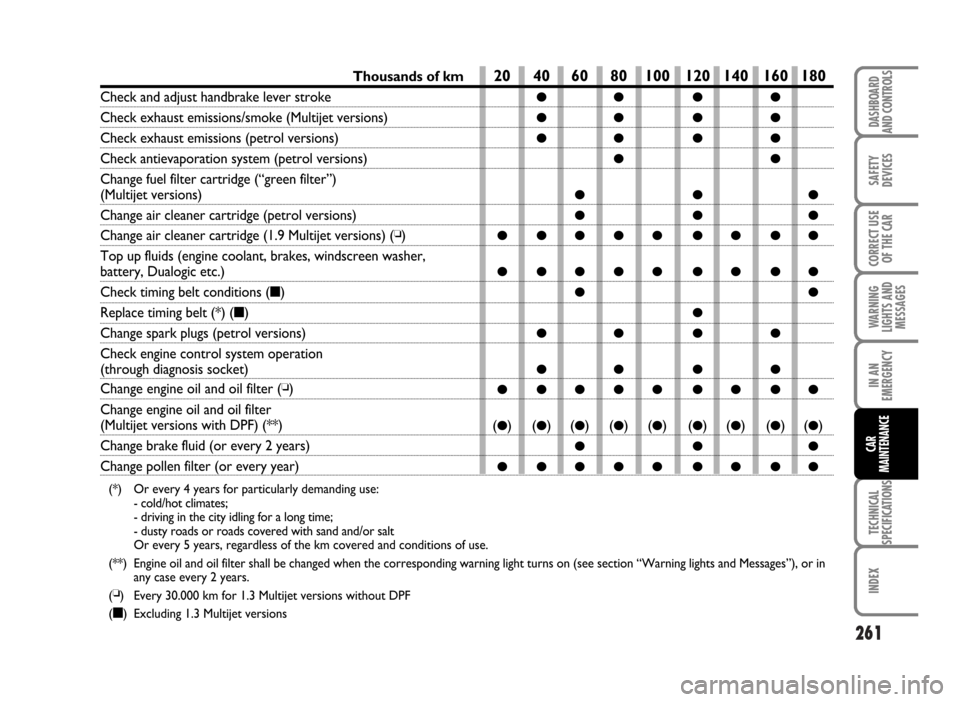
261
SAFETY
DEVICES
CORRECT USE
OF THE CAR
WARNING
LIGHTS AND
MESSAGES
IN AN
EMERGENCY
TECHNICAL
SPECIFICATIONS
INDEX
DASHBOARD
AND CONTROLS
CAR
MAINTENANCE
Thousands of km
Check and adjust handbrake lever stroke
Check exhaust emissions/smoke (Multijet versions)
Check exhaust emissions (petrol versions)
Check antievaporation system (petrol versions)
Change fuel filter cartridge (“green filter”)
(Multijet versions)
Change air cleaner cartridge (petrol versions)
Change air cleaner cartridge (1.9 Multijet versions) (❏)
Top up fluids (engine coolant, brakes, windscreen washer,
battery, Dualogic etc.)
Check timing belt conditions (■)
Replace timing belt (*) (■)
Change spark plugs (petrol versions)
Check engine control system operation
(through diagnosis socket)
Change engine oil and oil filter (❏)
Change engine oil and oil filter
(Multijet versions with DPF) (**)
Change brake fluid (or every 2 years)
Change pollen filter (or every year)
(*) Or every 4 years for particularly demanding use:
- cold/hot climates;
- driving in the city idling for a long time;
- dusty roads or roads covered with sand and/or salt
Or every 5 years, regardless of the km covered and conditions of use.
(**) Engine oil and oil filter shall be changed when the corresponding warning light turns on (see section “Warning lights and Messages”), or in
any case every 2 years.
(
❏) Every 30.000 km for 1.3 Multijet versions without DPF
(
■) Excluding 1.3 Multijet versions
20 40 60 80 100 120 140 160 180
●● ● ●
●● ● ●
●● ● ●
●●
●●●
●●●
●●●●● ●●●●
●●●●● ●●●●
●●
●
●● ● ●
●● ● ●
●●●●● ●●●●
(●)(●)(●)(●)(●)(●)(●)(●)(●)
●●●
●●●●● ●●●●
Page 263 of 314
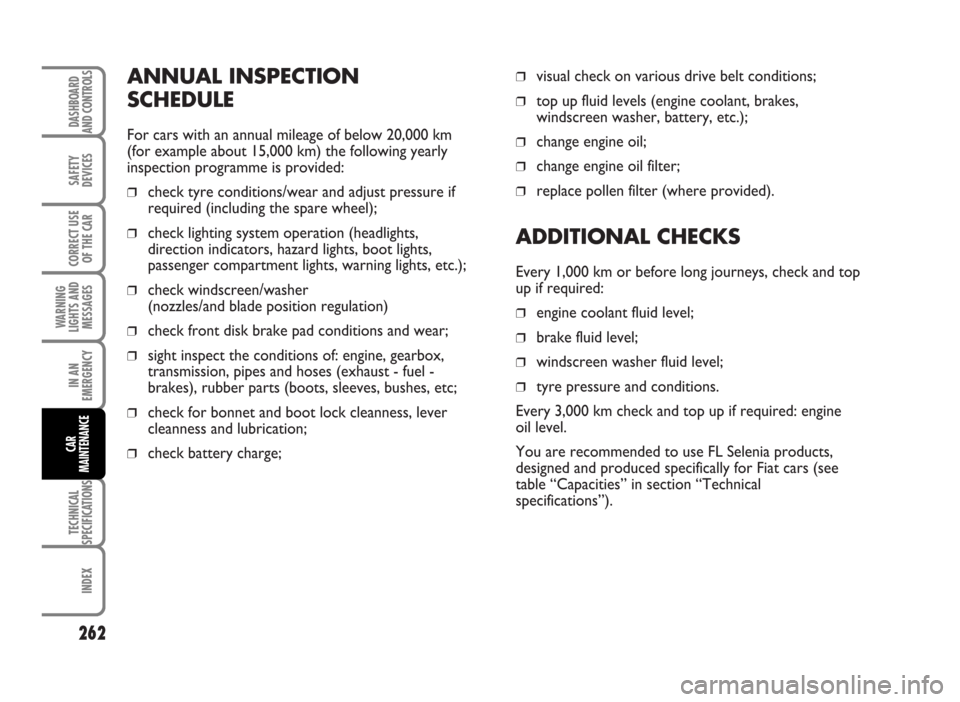
ANNUAL INSPECTION
SCHEDULE
For cars with an annual mileage of below 20,000 km
(for example about 15,000 km) the following yearly
inspection programme is provided:
❒check tyre conditions/wear and adjust pressure if
required (including the spare wheel);
❒check lighting system operation (headlights,
direction indicators, hazard lights, boot lights,
passenger compartment lights, warning lights, etc.);
❒check windscreen/washer
(nozzles/and blade position regulation)
❒check front disk brake pad conditions and wear;
❒sight inspect the conditions of: engine, gearbox,
transmission, pipes and hoses (exhaust - fuel -
brakes), rubber parts (boots, sleeves, bushes, etc;
❒check for bonnet and boot lock cleanness, lever
cleanness and lubrication;
❒check battery charge;
❒visual check on various drive belt conditions;
❒top up fluid levels (engine coolant, brakes,
windscreen washer, battery, etc.);
❒change engine oil;
❒change engine oil filter;
❒replace pollen filter (where provided).
ADDITIONAL CHECKS
Every 1,000 km or before long journeys, check and top
up if required:
❒engine coolant fluid level;
❒brake fluid level;
❒windscreen washer fluid level;
❒tyre pressure and conditions.
Every 3,000 km check and top up if required: engine
oil level.
You are recommended to use FL Selenia products,
designed and produced specifically for Fiat cars (see
table “Capacities” in section “Technical
specifications”).
262
SAFETY
DEVICES
CORRECT USE
OF THE CAR
WARNING
LIGHTS AND
MESSAGES
IN AN
EMERGENCY
TECHNICAL
SPECIFICATIONS
INDEX
DASHBOARD
AND CONTROLS
CAR
MAINTENANCE
Page 264 of 314

IMPORTANT - Engine oil
Should prevailing use of the car be under one of the
following specially heavy conditions:
❒trailer or caravan towing;
❒dusty roads;
❒short distances (less than 7-8 km) repeated and
with external temperatures below zero;
❒frequently idling engines or long distance low speed
driving (e.g. taxis or door-to-door deliveries) or in
case of a long term inactivity;
replace engine oil more frequently than required on
“Service schedule”.
IMPORTANT - Air cleaner
If the car is used on dusty roads change the air cleaner
more frequently than the indications in the “Service
schedule”.
If in doubt as to how often the engine oil and air
cleaner should be changed according to how you use
the car, contact a Fiat Dealership.IMPORTANT - Pollen filter
If the vehicle is used frequently in dusty or heavily
polluted environments it is advisable to replace the
filtering element more frequently; in particular it
should be replaced if a reduction of the amount of air
admitted to the passenger compartment is noted.
IMPORTANT - Diesel filter
The possibility of topping up with diesel fuel not
complying with EN590 European Norm might make it
necessary to replace the filter more frequently than
indicated in the “Service schedule”.
263
SAFETY
DEVICES
CORRECT USE
OF THE CAR
WARNING
LIGHTS AND
MESSAGES
IN AN
EMERGENCY
TECHNICAL
SPECIFICATIONS
INDEX
DASHBOARD
AND CONTROLS
CAR
MAINTENANCE